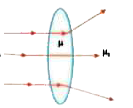A thin film of air between a plane glass plate and a convex lens is irradiated with parallel beam of monochromatic light and is observed under a microscope, you will see
Uniform brightness
Field crossed over by concentric bright and dark rings
Complete darkness
Field crossed over by parallel bright and dark fringes
The correct Answer is:D
Topper's Solved these Questions
Similar Questions
A thin slice is cut out of a glass cylinder along a plane parallel to its axis. The slice is placed on a flat glass plate with the curved surface downwards. Monochromatic light is incident normally from the top. The observed interference fringes from the combination do not follow on of the following statements.
View SolutionUnder what condition a convex lens when placed in a medium behaves as an ordinary glass plate?
View Solution
Knowledge Check
When a beam of light is passed through a colloidal solution and observed under ultramicroscope, we can see _____________.
Ashape of the colloidal particlesBrelative size of the colloidal particlesCfluorescenceDflashes of lightA beam of monochromatic light entering a glass window pane from the air will experience a change in
Afrequency nad wavelengthBfrequency and speedCspeed and wavelengthDspeed onlyThis question has a paragraph followed by two statements, Statement - 1 and Statement - 2. Of the given four alternatives after the statements, choose the one that describes the statements. A thin air film is formed by putting the convex surface of a plane-convex lens over a plane glass plate. With monochromatic light, this film gives an interference pattern due to light reflected from the top (convex) surface and the bottom (glass plate) surface of the film.
Statement - 1: When light reflects from the air-glass plate interface, the reflected wave suffers a phase change of π.
Statement - 2 : The centre of the interference pattern is dark.AStatement - 1 is true, Statement - 2 is true, Statement - 2 is the correct explanation of Statement -1.BStatement - 1 is true, Statement - 2 is true, Statement - 2 is not the correct explanation of Statement -1.CStatement - 1 is false, Statement -2 is true.DStatement -1 is true, Statement -2 is false.
Which of the two diverges a beam of parallel rays of light : convex lens or concave lens ?
View SolutionA thin slice is cut out of a glass cylinder along a plane parallel to its axis. The slice is placed on a flat glass plate with the curved surface downwards. Monochromatic light is incident normally from the top. The observed interference fringes from the combination do not follow on of the following statements.
View SolutionA convex lens of focal length 30 cm and a concave lens of 10 cm focal length are placed so as to have the same axis. If a parallel beam of light falling on convex lens leaves concave lens as a parallel beam, then the distance between two lenses will be
View SolutionIf parallel beam of light falls on a convex lens. The path of the rays is shown in fig. It follows that

View SolutionA converging lens of focal length f1 is placed in front of and coaxially with a convex mirror of focal length f2. Their separation is d. A parallel beam of light incident on the lens returns as a parallel beam from the arrangement, Then,
View Solution
